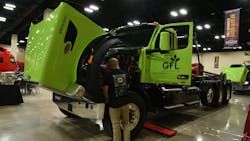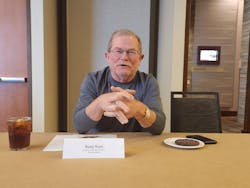SAN ANTONIO—In early December, Rusty Rush, CEO and president of Rush Enterprises, along with the company’s COO Michael McRoberts, sat down with a group of trucking journalists at the Rush Tech Skills Rodeo in December to discuss upcoming trucking trends and the impact of new technology. When asked about future predictions, of course electric vehicles made their way into the conversation.
“I'm probably more skeptical than everybody else,” offered McRoberts regarding electrification, “I don't think it's going to be as rapid of an adoption as people may think. If we did, it's just going to drive all kinds of economic craziness.”
The COO admitted he’s waiting to see what happens in the industry when the Environmental Protection Agency’s Clean Trucks Plan takes effect in 2027.
The final rule of the EPA plan is more than 80% stricter than current emissions standards, and additional EPA standards that have yet to be final include even more stringent emissions reductions. The White House predicts these standards will push OEMs to rely on fully electric vehicles to reach compliance, and the “EPA estimates that by 2032, if finalized, the proposed rules could result in electrification of … 50% of new vocational vehicles...; 35% of new short-haul freight tractors; and 25% of new long-haul freight tractors.”
The dealer, which has about 200 total locations (including 150 Rush Truck Centers) across the U.S., is working to “electrify” all its facilities in California in advance of the CARB regulations and Advanced Clean Fleet Regulations being instituted. But the percentage of electric trucks on the road will be largely dependent upon the OEMs’ ability to develop EVs that are just as capable as ICE vehicles—especially for trucking applications—and make economic sense.
Read more: Analysis: The dark side of electrification
Right now, an electric semi-truck gets roughly 200 to 300 miles per charge, McRoberts said, and these trucks cost $400,000. “You need two of them to replace one—what's the economics in that?”
Rusty Rush brought up government-funded subsidies and tax incentives that encourage the purchase of electric vehicles, acknowledging that fleets won't be able to rely on these subsidies and incentives in the future.
“The dollars at this point just don't play out right,” Rush told the group. “You can't subsidize everything forever. Eventually, it has to stand on its own two feet.”
Economics aside, by 2035, California will require all light-duty fleet vehicle purchases to be electric, with 100% medium-duty and heavy-duty vehicle purchase mandates coming soon after.
“That’ll be the truth serum, right there,” McRoberts said, explaining that one California-based Rush customer has already told him they have no plans to purchase a single electric vehicle within the foreseeable future.
Fitting EVs into the industry
The pair clearly showed their skepticism of electric vehicles being the zero-emission answer to all aspects of trucking, emphasizing that it probably doesn’t have a place in truckload applications in the near future.
“It’s too much weight. It costs too much money,” Rush said. “People will say, ‘With electric, you’re not going to spend as much money on maintenance.’ But it’s going to take more to haul the same amount of freight in my mind.”
Regardless, they both agreed the powertrain did have a place in the industry.
“I believe (EVs) will end up being market-segment driven,” Rush said. “It’s going to work well for medium duty.”
Read more: Two fleets weigh in on their EV transition progress
Echoing the company's president, McRoberts said there’s a place for EVs in trucking, but “it's going to have to be engineered short haul, light load, but there is a place for it,” he said, although clarifying that those advancements will require more strategic measures, and the pace of those advancements will be in “inches."
Another crucial step to full electrification is having the infrastructure to support the transition and the funds to build that infrastructure.
“When it comes to electrification, we’ve got a grid to fix, folks,” Rush explained. “We don't even have a grid or the infrastructure (to support full electrification), and everyone is trying to do all this while they're electrifying all the automobiles at the same time. [It] just doesn't make a lot of sense to me.”
“There's 110 years of internal combustion infrastructure out there, folks, and you can't change it in three, four or five years. You just can't do it that quick,” Rush said. “Will we get there one day? Sure, we will ... But you can't do it this fast. I just don't believe it's feasible. Or somebody's going to have to come up with the money.”
About the Author

Jade Brasher
Senior Editor Jade Brasher has covered vocational trucking and fleets for the past five years. A graduate of The University of Alabama with a degree in journalism, Jade enjoys telling stories about the people behind the wheel and the intricate processes of the ever-evolving trucking industry.

